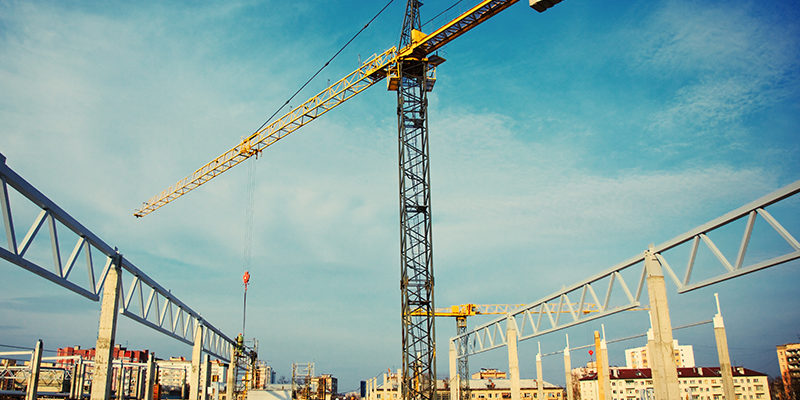As construction activity hits pre-recession levels, construction cranes increasingly dot city skylines and neighborhoods nationwide. There were roughly 400 cranes across 14 major U.S. cities in July 2017 – a figure that is only increasing, as the Dodge Momentum Index leaped 14% in November, the second straight month of healthy gains coming from the commercial and institutional sectors.
Cranes are used to lift and lower materials and to move them horizontally, and they are generally equipped with a hoist rope, wire ropes or chains, and sheaves. Cranes are necessary for many construction projects, particularly large, multi-story commercial, residential, or office space buildings, which continue to increase in metropolitan areas around the U.S.
As infrastructure, the skilled labor shortage, and the need to rebuild after Hurricanes Harvey and Maria continue to dominate industry news, conversations around the risks and dangers of cranes are also increasing – and with good reason.
Potential Hazards
Construction cranes are massive, complex machines that can reach up to 230 feet and lift almost 20 tons. These machines come with inherent risks, including collapse, and damage to humans or sites. It is important to plan for such risks and to put safeguards in place to prevent operator or bystander injuries and costly site damage.
- Crane Collapse – A number of factors or scenarios can lead to a crane collapse, including old machinery that has not been properly maintained. Improper usage, such as attempting to operate a crane at an incline or exceeding its lifting weight limit, is another key culprit. Extreme weather, including the high winds that accompany hurricanes, can also lead to crane collapses. In January 2016, three pedestrians were injured and one pedestrian was killed in New York City following a high wind-induced crane collapse. Most recently, the issue of securing cranes for impending extreme weather and preparing for high winds came into focus with Hurricanes Harvey and Maria.
- Collision – While less common, crane collisions are also something to look out for. In some instances, crane operators – which must complete and maintain rigorous training – may not see a crew member if he/she is not wearing hi-viz clothing or fails to avoid the warning zone around cranes. Likewise, if an operator is not vigilant or fails to carefully monitor his or her surroundings, a collision or accident can occur.
Means of Keeping Your Crew Safe
There are several ways to help keep your crew safe when it comes to crane transportation, operation and maintenance, including:
- Making sure crane operators are trained and certified by an accredited certification provider. In order to become a certified crane operator, individuals must find an accredited crane operator training program, complete the training program, enroll in an apprenticeship program, and obtain their certification. The National Commission for the Certification of Crane Operators, or NCCCO, as one example, requires workers to meet medical requirements, comply with the NCCCO’s substance abuse policy, pass written exams (core and at least one specialty), and pass their practical exams. For workers, proper certification does not just mean reduced risk of loss and improved safety, but presents an opportunity for continued career advancement.
- Know your cranes. Firstly, crane operators should know the design of their cranes and have access to the full manuals. Next, contractors should establish procedures and priorities for the crane’s operation, including properly inspecting and load testing the crane, both when they first arrive on site and on a periodic basis. As always, the most effective plan for accident prevention is the identification and elimination of hazards during design and preconstruction phases, and contractors should analyze the crane’s location and access, the impact of crane operations on the public, and nearby power lines, to name a few.
- Utilize sensor-based safety technology. Technology exists today to manage and ensure training compliance and help alert to – and prevent – a potential incident. The Spot-r EquipTag combines worker identity and certification information with equipment or machine activity to send automatic alerts in case of an unauthorized or unknown crane operator. Similarly, proximity sensing technology can alert operators or crews if they are about to collide with one another. These sensors are designed to vibrate or sound an alarm when the operators and crew members are in close proximity to each other. Proximity sensors on cranes may also alert operators if they are too close to buildings or other machinery, thereby preventing collisions.
How to Keep Bystanders Safe
Of course, when it comes to crane safety, you should be concerned with public safety as well. With solid planning, communication, and monitoring, you can keep bystanders and community members informed and safe.
- Plan ahead. It is important to examine and analyze the jobsite – and its surroundings – for potential risks to bystanders. Can the cranes be placed in a spot where if – worst case – they were to topple, they would not fall into bystanders’ paths? Is it possible to avoid using cranes during high-traffic times of day when people are rushing to work or school? Work with your organization and the local community to come up with a “pedestrian safety plan.”
- Communicate regularly. Along those lines, you need to communicate jobsite activities and risks with the local community. It could be as simple as writing an article for the local newspaper, posting clear safety signs and information across perimeter fencing, or letting pedestrians know ahead of time that a crane will be in use. Provide a clear alternate path that pedestrians can take to minimize risk exposure and consider local community meetings to brief residents on the situation.
- Come up with an incident plan. It is essential to have a plan of action in the event that an incident does occur. If a crane should fall onto a neighboring building, for example, what will safe evacuation look like? How will you communicate with outside emergency response teams? What is the protocol for operators and crews on the ground – do they get to their muster point, check in, and then proceed to helping others? If a crane topples on the worksite, you and your crew should know exactly what to do – and in which order – to keep everyone safe.
Crane incidents are rare, but when they do occur, they are often disastrous and fatal. Though you may think the risks of such an incident are low, failing to plan is planning to fail. Make safe equipment training, operation and maintenance a regular part of safety talks, check-ins and reporting. Work with the local community to communicate project objectives, logistics and timeframes and create a crane safety plan, so you, your crew, and passing pedestrians aren’t caught off-guard.
Enhance Crane Safety on Your Construction Site with Triax Technologies
Ready to prioritize safety and mitigate risks associated with construction cranes on your worksite? Take the next step and request a demo or contact Triax today. Our advanced IIoT platform technology solutions are designed to revolutionize crane safety with sensor-based alerts to prevent collisions and real-time monitoring of equipment activity. With Triax, you can ensure that your crew and bystanders are protected while maximizing productivity. Don’t wait – reach out to Triax now to experience the future of worksite safety by requesting a demo or contacting our team of experts.

